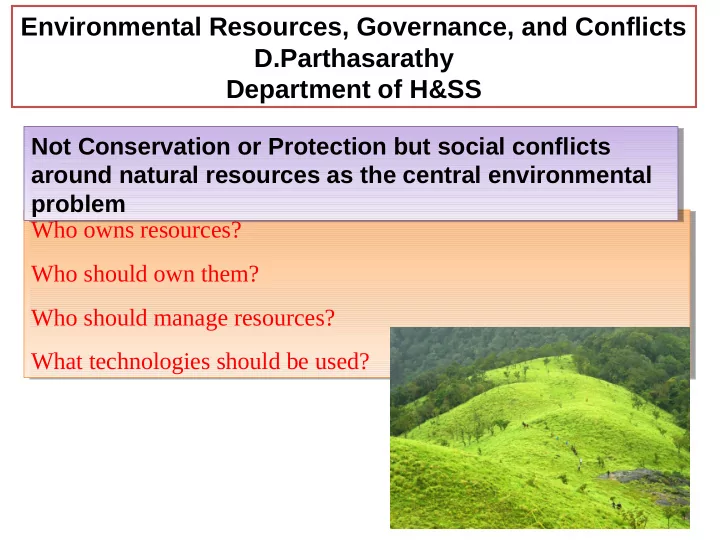

Environmental Resources, Governance, and Conflicts D.Parthasarathy Department of H&SS Not Conservation or Protection but social conflicts Not Conservation or Protection but social conflicts around natural resources as the central environmental around natural resources as the central environmental problem problem Who owns resources? Who owns resources? Who should own them? Who should own them? Who should manage resources? Who should manage resources? What technologies should be used? What technologies should be used?
Why are there struggles / conflicts around natural resources? Why are there struggles / conflicts around natural resources? Why are we not able to share resources equitably? Why are we not able to share resources equitably? To whom should resources belong? Private, public, common? To whom should resources belong? Private, public, common? How should resources be governed or managed? Rules and How should resources be governed or managed? Rules and Regulations, customs and traditions Regulations, customs and traditions Which form of ownership or control is better for preventing Which form of ownership or control is better for preventing resource depletion? resource depletion? Why does resource degradation occur? Why does resource degradation occur? Should resources be shared equitably, or, be owned / used only Should resources be shared equitably, or, be owned / used only by those who can afford to pay? by those who can afford to pay? Should we pay for natural resources? How much should we pay? Should we pay for natural resources? How much should we pay?
Understanding Environment-Society Interactions Understanding Environment-Society Interactions and their consequences and their consequences Chipko Chipko Silent Valley Silent Valley Water conflicts Water conflicts Plachimada Plachimada Dams and mutli-purpose projects Dams and mutli-purpose projects Bhopal Bhopal Green revolution Green revolution Forest Rights Forest Rights
Chipko Movement
Chipko: Government, Paper Mills / Loggers, People Sunderlal Bahuguna Chandi Prasad Bhatt
Forest Rights Act: Government, Forest based communities
Plachimada: Private ownership vs public access to water Plachimada: Private ownership vs public access to water (Coca Cola) (Coca Cola) To whom does ground water belong? To whom does ground water belong? Adivasi Samkrashana Sangham (Adivasi Adivasi Samkrashana Sangham (Adivasi Protection Front) Protection Front)
Environment, Governance, and the state Environment, Governance, and the state How do humans interact with ecosystems to maintain long-term sustainable How do humans interact with ecosystems to maintain long-term sustainable resource yields? resource yields? What form of ownership and governance is best for sustainability? For What form of ownership and governance is best for sustainability? For preventing resource degradation or depletion? For ensuring equitable preventing resource degradation or depletion? For ensuring equitable access? access? • • Regulation Regulation • • Ownership Ownership Experiments in Resource Governance to promote equitable access and environmental sustainability 1.Forest Rights Act: Gajab Kahani - Struggle for Forest Rights: http://www.youtube.com/watch?v=EES2KtIdI3k 2.Natural Resource Management in Rural India: How Anna Hazare greened Ralegan: http://www.youtube.com/watch?v=aBfjsdICGT0
Recommend
More recommend